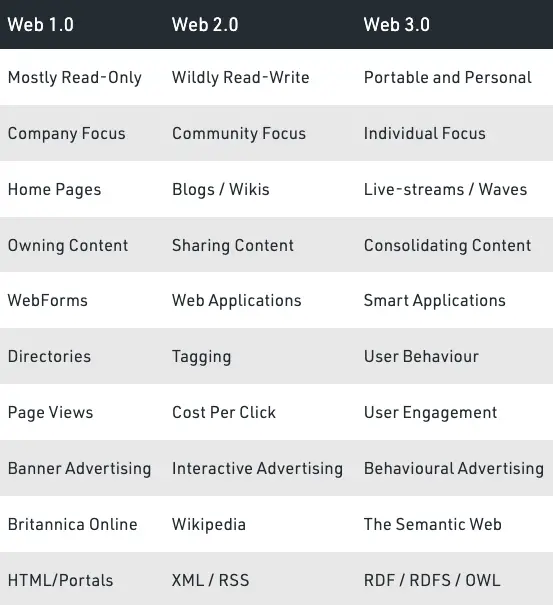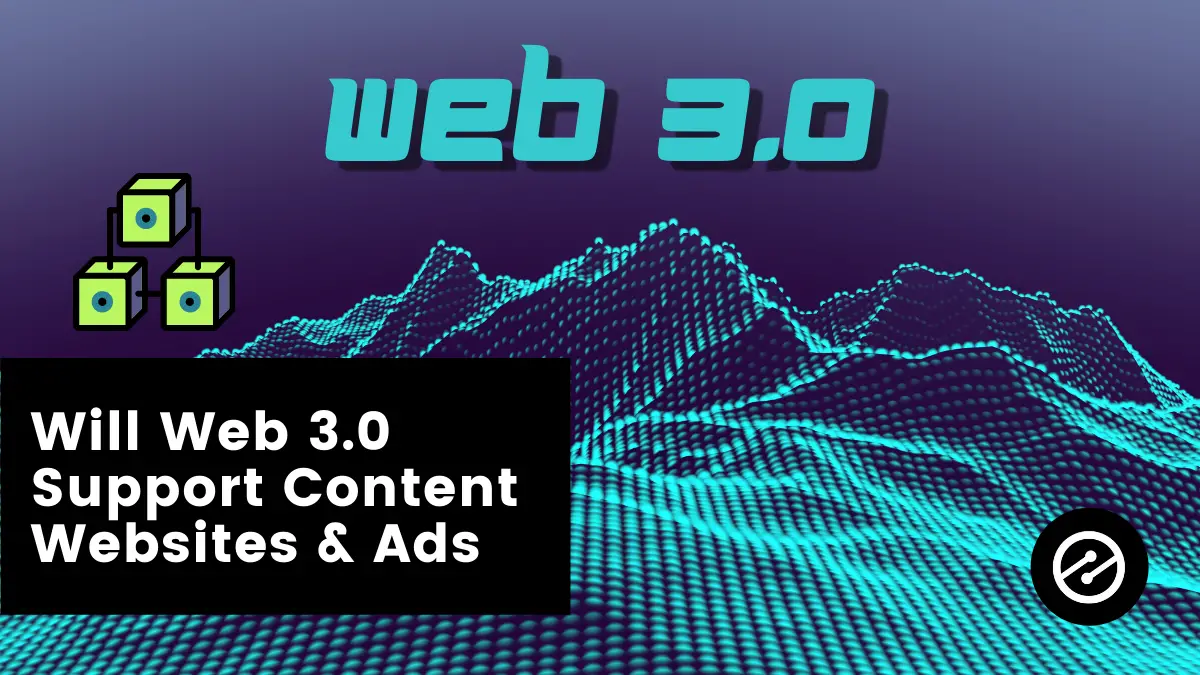Cryptocurrency. Blockchain. Metaverse. Virtual reality. Web 3.0. All of these are the newest concepts and buzzwords surrounding the world of tech.
By now, you may have heard about Web3 also known as Web 3.0. But what is it exactly? We’ll talk about how things have gotten in motion, as well as where Web 3.0 is headed.
Evolution of the internet
First, what are the previous iterations of the web? Let’s go back briefly to get a better understanding.
Web 1.0 was the first stage of the internet. The late 1980’s until late 1990s/early 2000s was when this change was occurring. The internet at this point in time was read-only, meaning there was very little user interaction like we see today. Its main purpose was the spread of information, like an encyclopedia.
After the dot com bubble came Web 2.0, or the current state of the internet. As you already know, we’re now focused on rich applications, user generated content, and increased interactivity. Think about personal data.
Take a look at this brief summary of the differences between versions. Here you’ll notice a few of the defining features and characteristics of each iteration.

What is Web 3.0?
Web 3.0 isn’t easily summed up. You won’t find a definition on an objective internet knowledge base.
It can briefly be described as the evolution of web utilization and interaction which includes altering the Web into a database. It enables the up-gradation of the back-end of the web, after a long time of focus on the front-end.
Think of Web 3.0 as a term that is used to describe many evolutions of web usage and interaction among several paths. In this, data isn’t owned but instead shared, where services show different views for the same web/the same data.
Web 3.0’s decentralized blockchain protocol will enable individuals to connect to an internet where they can own and be properly compensated for their time and data. This is where things like cryptocurrency and NFTs come into play.
Another analogy that comes to mind is Pied Piper and their dream for a decentralized internet. Putting the web back in the hands of the users.

Why it’s important
This movement or initiative if you will, is focused on giving the power back to users and away from large corporations. As it’s been well advertised and discussed in recent years, the monetization of the user’s personal data is a piece of our daily life that’s been accepted reluctantly.
If you care about the possibility of regaining ownership of your personal data, you should care about Web 3.0. If you wish to use an internet that provides equal benefit to all users, you can be excited about Web 3.0.
Furthermore, if you understand the benefits of decentralization, it’s time to recognize the importance of Web 3.0. If you remember the original vision for the World Wide Web, Web 3.0 is in many ways a manifestation of that. It’s taken a few tweaks, but it appears we’re approaching the start of this new era.
Impact on content sites
Now, the topic of discussion is where will content sites fall in relation to the new Web 3.0 efforts.
Sites that’s main objective are to provide information or entertainment are clearly different from those who work as a service or someone with large amounts of data – like any sort of user-generated, Web 2.0 content site like Facebook.
In terms of advertising, all signs point to even more rich and interactive opportunities than what currently exists. Will the structure of ad buying and selling change? It’s possible, and most likely for the better.
A prediction that’s already somewhat happening with Google is that niches and categories of sites with similar audiences will be lumped together. This way those companies who buy these ads would get a tailored audience to their needs and site owners would get higher ad rates.
At this moment in time, there’s an enormous learning curve for those looking to implement Web 3.0 principles onto a content type of site.
The jargon you read online and through Silicon Valley informants isn’t always the easiest to digest. There’s a lot of pockets within Web 3.0 to explore but this early, it’s difficult, expensive, and going to be much different than what you read in media.
With that said, you still can never be too early to a trend. The internet of blockchains does have really unique opportunities for publishers, but it may be initially reserved for the more technically savvy publishers with a desire to be on the cutting edge.
If you’re interested in learning more, look to some of your favorite brands or people to see if they’re investing their time towards this revolution.

In summary
The point is, Web 3.0 is just beginning now. In all likelihood, it will continue to grow and evolve for the next 10 years. Is the bandwidth and computing power there in it at this moment in time? No. However, it’s certainly encouraged to build your knowledge base.
It’s a humbling moment when long-time engineers admit it’s like starting over and they feel like they know nothing. Wonder how that makes the rest of us feel.
In short, we’re approaching an era that’s similar to what was happening in the late 1990s. Digitally owning something through the blockchain is a disruptive trend that’s expected to grow. So far in January of 2022, there’s been over $1B in transactions on OpenSea – a marketplace for NFTs and it’s only going to get larger.
Our move to blockchain technology and a decentralized system should be exciting. And while it won’t be seamless or overnight, expect to hear more as time goes on.

